Poverty and Income Inequality in Scotland 2013/14
The latest National Statistics on poverty and income inequality in Scotland, up to and including 2013/14.
Chapter 2: Income Inequality and the distribution of income
2.1 Income Inequality – the Gini coefficient
Key points:
- The Gini coefficient, which measures the degree of inequality in household income, was 30 in 2013/14. This is a decrease from 31 in 2012/13, mainly due to increases in incomes at the bottom of the distribution and decreases at the top.
- Income inequality, as measured by the Gini coefficient, has remained largely unchanged over the last four years.
The Gini coefficient is a measure of how equally income is distributed across the population. It takes a value between 0 and 100 with 0 representing perfect equality where every person has the same income. The larger the Gini coefficient, the more people towards the top of the income distribution have a greater share of overall income with a value of 100 representing the case where one individual has all the income. In practice, the proportion of overall income going to each individual increases gradually across the income distribution.
For Scotland, the Gini coefficient has been between 30 and 34 over the last decade. In 2013/14, the Gini coefficient for Scotland was 30, a 1 percentage point decrease compared with 2012/13.
Chart 6 – Inequality of household income as measured by the Gini coefficient
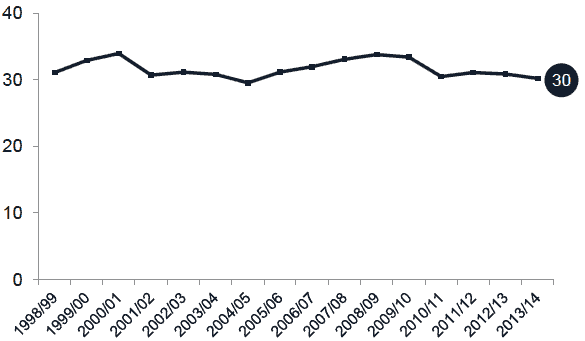
Source: HBAI dataset, DWP. These figures are also presented in Annex 1 (Table A14).
Income inequality in Scotland increased gradually until the onset of the recession. In 2010/11, income for the top 10 per cent fell, resulting in a reduction in income inequality. It has remained largely flat since then, with a small decrease in 2013/14 due to increases in incomes at the bottom of the distribution and decreases at the top.
2.2 Income distribution
Key points:
- The percentage of income received by the lowest 3 income deciles in 2013/14 was 14 per cent, unchanged from 2012/13. There has been very little change in this measure of income inequality since 1998/99.
This section provides information that relates to the Scottish Government’s Solidarity Purpose Target which is “to increase overall income and the proportion of income earned by the three lowest income deciles as a group by 2017” . More information can be found at the following link:
http://www.gov.scot/About/Performance/scotPerforms/purpose/solidarity
Chart 7 shows the percentage of total income received by the three lowest income deciles (the thirty per cent of the population with the lowest incomes), from 1998/99 to 2013/14. It also shows the percentage of total income received by the three highest income deciles. This is another measure of how equally income is distributed across the population.
Chart 7 – Percentage of income going to the bottom and top three deciles
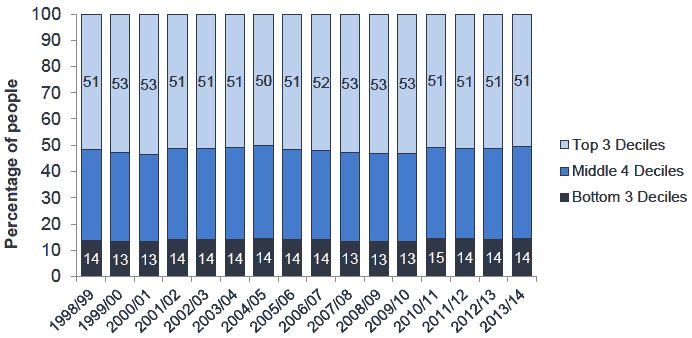
Source: HBAI dataset, DWP.
Commentary:
In 2013/14, the percentage of income received by households in the bottom 3 deciles was 14 per cent, unchanged from the previous 2 years.
Having dropped from 53 per cent to 51 per cent between 2009/10 and 2010/11, the percentage of income received by households in the top three income deciles has remained unchanged since then.
There has been no significant change in income inequality between 2012/13 and 2013/14 using this measure. Over the longer term it can be seen that there has been very little change in this indicator since 1998/99, with the percentage of income received by the bottom 3 deciles remaining between 13 and 15 per cent.
Deciles / decile points:
Deciles (or decile points) are the income values which divide the Scottish population, when ranked by income, into ten equal-sized groups. Therefore nine decile points are needed in order to form the ten groups. Decile is also often used as a shorthand term for decile group; for example ‘the bottom decile’ is used to describe the bottom ten per cent of the income distribution.
Decile groups:
These are groups of the population defined by the decile points. The lowest decile group is the ten per cent of the population with the lowest incomes. The second decile group contains individuals with incomes above the lowest decile point but below the second decile point.
2.3 Income thresholds
Key points:
- Median income in Scotland in 2013/14 was £24,000, equivalent to £460 per week. Median income in Scotland has increased in 2013/14, following three years of decreases.
- The poverty threshold BHC in 2013/14 was £14,200, equivalent to £272 per week. This was the same as the previous two years, meaning any changes in relative poverty reflect genuine changes in income and are not due to changes in UK median income.
- A couple with no children with a combined income of over £36,300 (after tax and benefits) would be in the highest income 20 per cent of the population. With an income over £44,300 they would be in the top 10 per cent.
Most of the income figures in this publication are based on equivalised income. One consequence of the equivalisation process is that there are different poverty thresholds for households of different sizes and compositions. To help readers understand the figures in this publication, Table 1 below presents some commonly used income thresholds, before equivalisation, for households of different sizes. The incomes presented elsewhere in this report use the value for “Couple with no children” as the standard, and all other household types are adjusted to reflect their different household composition. Table 2 shows the same information after housing costs have been taken into account.
Table 1 - Income thresholds (£) for different household types before housing costs (income after tax and transfers) – 2013/14
| Single person with no children |
Couple with no children |
Single person with children aged 5 and 14 |
Couple with children aged 5 and 14 |
|||||
|---|---|---|---|---|---|---|---|---|
| weekly |
annual |
weekly |
annual |
weekly |
annual |
weekly |
annual |
|
| UK median income (before housing costs) |
304 |
15,800 |
453 |
23,600 |
544 |
28,400 |
693 |
36,100 |
| Scottish median income (before housing costs) |
308 |
16,100 |
460 |
24,000 |
551 |
28,800 |
703 |
36,700 |
| 60% of UK median income (before housing costs) - relative poverty threshold |
182 |
9,500 |
272 |
14,200 |
326 |
17,000 |
416 |
21,700 |
| 60% of inflation adjusted 2010/11 UK median income (before housing costs) - absolute poverty threshold |
188 |
9,800 |
280 |
14,600 |
336 |
17,500 |
428 |
22,300 |
| Scottish 1st income decile |
163 |
8,500 |
243 |
12,700 |
292 |
15,200 |
372 |
19,400 |
| Scottish 2nd income decile |
202 |
10,500 |
301 |
15,700 |
361 |
18,800 |
460 |
24,000 |
| Scottish 3rd income decile |
234 |
12,200 |
350 |
18,200 |
420 |
21,900 |
535 |
27,900 |
| Scottish 4th income decile |
267 |
13,900 |
399 |
20,800 |
479 |
25,000 |
611 |
31,800 |
| Scottish 5th income decile |
308 |
16,100 |
460 |
24,000 |
551 |
28,800 |
703 |
36,700 |
| Scottish 6th income decile |
350 |
18,300 |
523 |
27,300 |
628 |
32,700 |
800 |
41,700 |
| Scottish 7th income decile |
401 |
20,900 |
599 |
31,200 |
719 |
37,500 |
917 |
47,800 |
| Scottish 8th income decile |
466 |
24,300 |
695 |
36,300 |
834 |
43,500 |
1064 |
55,500 |
| Scottish 9th income decile |
569 |
29,700 |
849 |
44,300 |
1019 |
53,100 |
1299 |
67,700 |
Source: HBAI dataset, DWP.
Note: to create ten decile groups only nine decile points are needed to split the population.
Table 2 - Income thresholds (£) for different household types after housing costs (income after tax and transfers) – 2013/14
| Single person with no children |
Couple with no children |
Single person with children aged 5 and 14 |
Couple with children aged 5 and 14 |
|||||
|---|---|---|---|---|---|---|---|---|
| weekly |
annual |
weekly |
annual |
weekly |
annual |
weekly |
annual |
|
| UK median income (after housing costs) |
259 |
13,500 |
386 |
20,100 |
464 |
24,200 |
591 |
30,800 |
| Scottish median income (after housing costs) |
275 |
14,300 |
411 |
21,400 |
493 |
25,700 |
628 |
32,800 |
| 60% of UK median income (after housing costs) - relative poverty threshold |
155 |
8,100 |
232 |
12,100 |
278 |
14,500 |
355 |
18,500 |
| 60% of inflation adjusted 2010/11 UK median income (after housing costs) - absolute poverty threshold |
162 |
8,500 |
242 |
12,600 |
291 |
15,100 |
370 |
19,300 |
| Scottish 1st income decile |
119 |
6,200 |
178 |
9,300 |
213 |
11,100 |
272 |
14,200 |
| Scottish 2nd income decile |
163 |
8,500 |
244 |
12,700 |
292 |
15,200 |
373 |
19,400 |
| Scottish 3rd income decile |
198 |
10,300 |
296 |
15,400 |
355 |
18,500 |
453 |
23,600 |
| Scottish 4th income decile |
234 |
12,200 |
349 |
18,200 |
419 |
21,800 |
534 |
27,800 |
| Scottish 5th income decile |
275 |
14,300 |
411 |
21,400 |
493 |
25,700 |
628 |
32,800 |
| Scottish 6th income decile |
313 |
16,300 |
468 |
24,400 |
561 |
29,300 |
715 |
37,300 |
| Scottish 7th income decile |
361 |
18,800 |
539 |
28,100 |
646 |
33,700 |
824 |
43,000 |
| Scottish 8th income decile |
423 |
22,100 |
631 |
32,900 |
757 |
39,500 |
966 |
50,400 |
| Scottish 9th income decile |
532 |
27,700 |
794 |
41,400 |
953 |
49,700 |
1215 |
63,300 |
Source: HBAI dataset, DWP.
Note: to create ten decile groups only nine decile points are needed to split the population.
2.4 Trends in income distributions
Key points:
- Median household income increased in 2013/14, following three years of decreases.
- Median household income for working age adults increased in 2013/14, following three years of decreases. However median income for households with children decreased in 2013/14, the fourth consecutive annual decrease. Pensioner median household income decreased in 2013/14, following an increase in the previous year.
- In 2013/14, the bottom two deciles saw the largest increase in income compared to the previous year. However, they were still lower than in 2011/12 due to the large decreases in 2012/13.
- Incomes increased or stayed the same at all deciles apart from the top decile, which decreased in 2013/14. The top decile returned to the same level as in 2011/12 having seen the largest increase in 2012/13.
Chart 8A – Median weekly household income in Scotland (in 2013/14 prices)
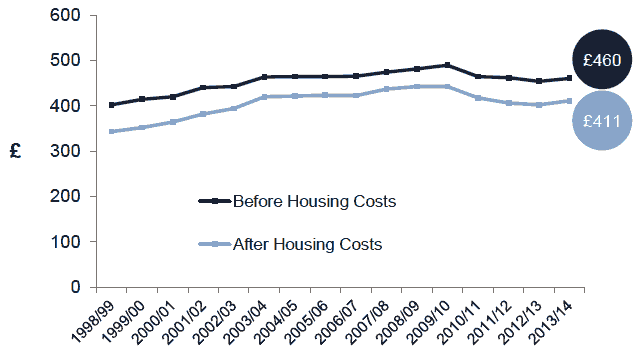
Source: HBAI dataset, DWP. These figures are also presented in Annex 1 (Table A8).
Chart 8B – Median weekly household income BHC in Scotland for children, working age adults and pensioners (in 2013/14 prices)
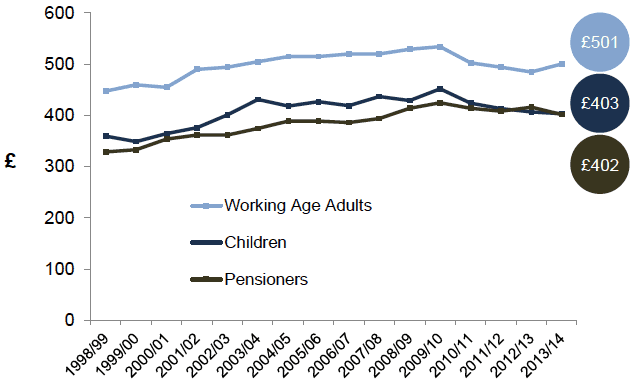
Chart 8C – Median weekly household income AHC in Scotland for children, working age adults and pensioners (in 2013/14 prices)
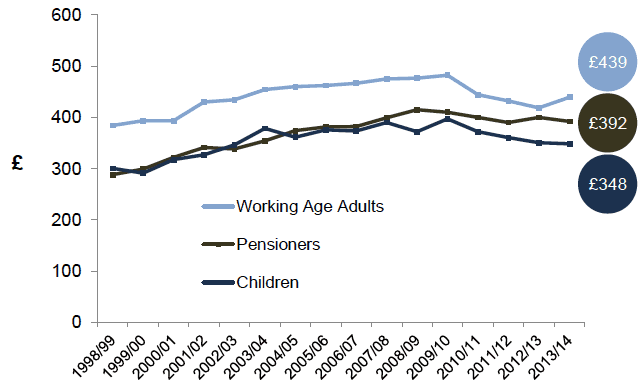
Source: HBAI dataset, DWP. These figures are also presented in Annex 1 (Table A9).
In 2013/14, median household income was £460 per week, an increase of £6 compared with 2012/13. This is the first increase in median income in Scotland since 2009/10. Median income had been increasing for the 10 years to 2009/10, then decreased for three years to 2012/13. The increase in median income in 2013/14 brings it back to the level seen in 2003/04 but still below the peak in 2009/10. All incomes are quoted in 2013/14 prices.
Commentary:
There was a gradual increase in median equivalised weekly household income BHC in Scotland to £489 in 2009/10. This was followed by 3 years of decreasing median incomes to £454 in 2012/13. Median income then increased to £460 in 2013/14 but this was smaller than the decrease in 2012/13 so the median income remained below the level of 2011/12.
The pattern is similar for median equivalised weekly household income AHC in Scotland, which was £343 in 1998/99, increasing to £442 in 2009/10, followed by annual decreases to 2012/13. Median income increased in 2013/14 to £411, above the level in 2011/12 but below the level in 2010/11.
Chart 9 shows how the weekly equivalised incomes have changed from 2009/10 to 2013/14 across the different income decile points. Decile points are the incomes that separate out the 10 deciles, so 10 per cent of the population have household income below the 1st decile point and 90 per cent of the population have income below the 9th decile point.
Chart 9 – Weekly household incomes for each decile point from 2009/10 to 20013/14
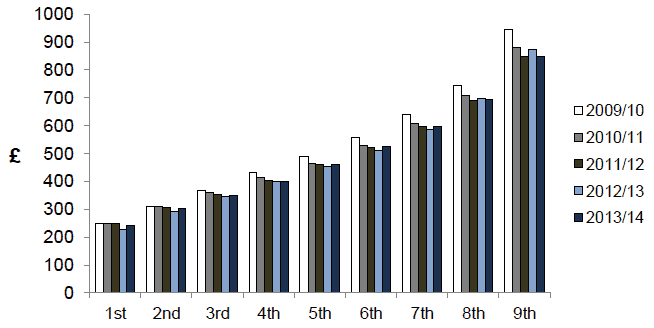
Source: HBAI dataset, DWP. These figures are also presented in Annex 1 (Table A10).
Incomes increased or saw no change at all deciles apart from the top decile in 2013/14. The top decile decreased to the same level as in 2011/12 having seen the largest increase in 2012/13. The bottom two deciles saw the largest increases, with little or no change for households across the middle of the income distribution.
Chart 10 – Percentage change in each decile point between 2012/13 and 2013/14 (in real prices)
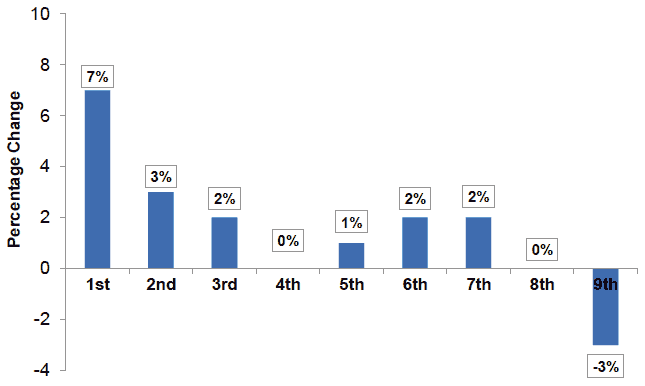
Source: HBAI dataset, DWP.
In 2013/14, the bottom two deciles saw the largest percentage increases. However they were still below the level of 2011/12 due to the decreases in 2012/13 being larger than the increases in the most recent year.
The only deciles that were at or above the level of 2011/12 were the top 4 deciles. The decrease in income at the top decile offset the increase in 2012/13, and so this has returned to the level seen in 2011/12, £849 per week (£44,300 per year).
Chart 11 below shows the distribution of weekly income across Scotland in 2013/14. The shaded area shows the shape of the 2013/14 income distribution and the black lines show the Scottish median income (£460) and the relative poverty threshold The dark blue line superimposed shows the 2012/13 income distribution for comparison.
Chart 11 – Distribution of weekly household income with Scottish median and relative poverty threshold BHC - 2013/14
for children, working age adults and pensioners
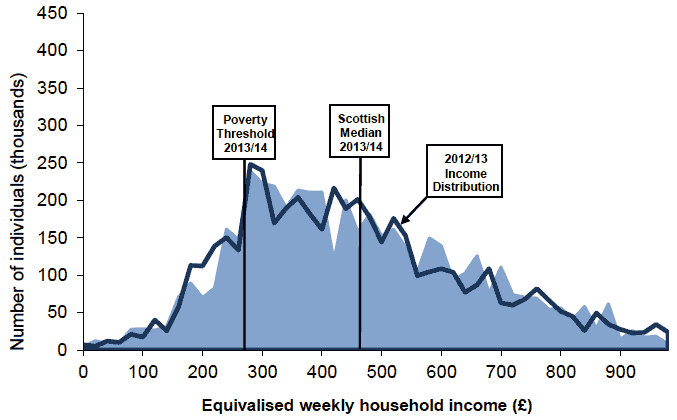
Source: HBAI dataset, DWP.
Chart 12 shows the same distribution with income deciles for Scotland marked with black lines.
Chart 12 – Distribution of weekly household income with income decile points
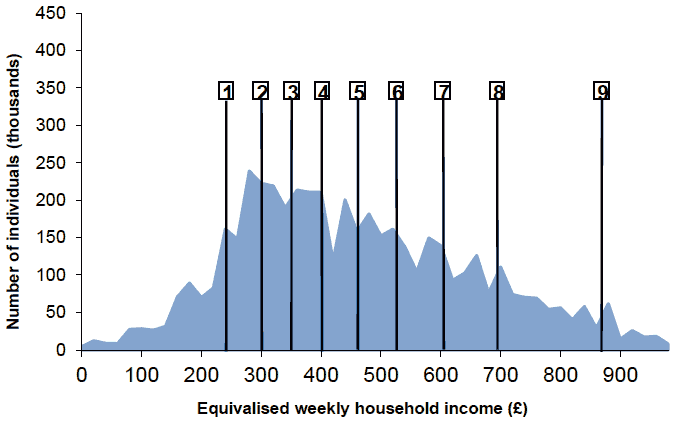
Source: HBAI dataset, DWP.
The relative poverty threshold BHC is based on the UK median equivalised household income. As the UK median income fell in 2011/12, the poverty threshold also fell in 2011/12. In 2012/13 and 2013/14, the UK median remained unchanged, as did the poverty threshold. In 2013/14 the poverty threshold BHC therefore remained at £272 per week (for a couple with no children). Median income in Scotland was higher than the UK median in 2011/12 but in 2012/13, it had dropped to almost the same level (£454 compared to £453 for the UK). In 2013/14 median income in Scotland increased to £460 while median income for the UK remained at £453.
Contact
Email: Stephen Smith
There is a problem
Thanks for your feedback